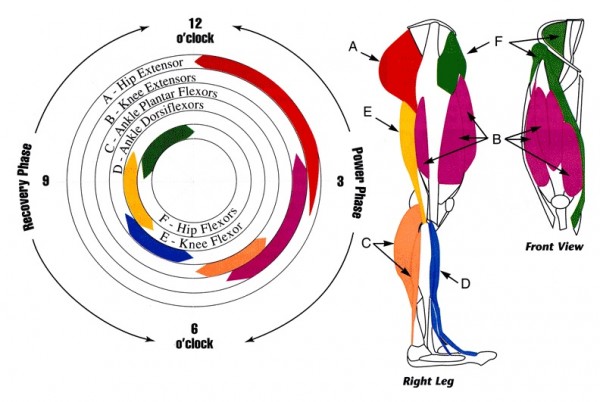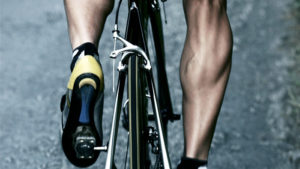It can be hard to discern just through sensation what muscles we actually used during a ride, and you might find yourself wondering what was really accomplished in terms of muscular activity. What muscles does cycling work? Some people say their lungs are working, but the lungs aren’t a muscle. It’s obvious our legs are working, but the leg is a big thing with many parts. Which of them are doing what? How? And at what time when we’re on the bike?
The science of cycling is unique in several ways because our sport is quite different than most. There’s those sports where you operate on your own two feet, and others (like cycling, rowing and kayaking) that support and move you in a seated position.
Today we want to tell you, and give you a brief overview of the different muscles you use while cycling. Some are far bigger contributors to your cycling performance than others, and some are just completely misunderstood. So let’s start with busting a major myth right off the bat. The idea that cycling builds big glutes.

Source: Rattanasak/Adobe Stock
Glutes
Unfortunately, it does not. Not to any great degree anyways. If you’re cycling to lift things up, make them more round and so on – you’re going to be quite disappointed. That is unless you’re coming from a place of very low fitness and activity (i.e. cycling is your first real form of exercise), in which case you will likely notice a difference, but only the same difference you would notice if starting any form of exercise.
If you’re relatively fit with a healthy body composition, the sport of cycling just doesn’t stimulate the gluteus maximus (your butt) enough for any real development. The gluteus maximus is the body’s primary hip extensor, it’s strong and big, and responds to intense, powerful hip extension like you see in a person sprinting or coming out of the bottom of a full depth squat.
The reason cycling negates its use is due to the range of motion your hip goes through while on the bike. If the hip doesn’t go past a certain degree of flexion, your body will not use the gluteus maximus to extend it. It’s too expensive, and the body is an energy conservation machine. It will instead resort to your secondary hip extensors, which are the hamstrings.
Source: Electromyographic Analysis of the Lower Extremity during Pedaling
Hamstrings
The graph above details this situation perfectly. This study placed individuals on a bicycle ergometer and had them pedal against changes in workload, pedal rates and other variables in seated and standing positions. The graph shows measures in electrical activity of different muscle groups throughout the test. Notice the difference between gluteus maximus and biceps femoris (your outer hamstring).
Your hamstrings have a primary function of flexing the knee, and a secondary function of extending the hip. When circumstances ask for hip extension, but the intensity requirement of that extension is low, your body resorts to a principle called synergistic dominance. This principle states that when a prime mover is inhibited (gluteus maximus), your body will use secondary movers (biceps femoris) to save energy and properly perform the function.
Conclusively, the hamstrings are far more responsible for hip extension while cycling than the glutes. On every downstroke your hamstrings are working to extend the hip down. Further, they also use their knee flexing function to start the upstroke. All of this work presents itself in the hamstring stiffness often seen globally among cyclists.
Source: fizkes/Adobe Stock
Quadriceps
Let’s move on to the real workhorse muscles used while cycling, the quadriceps. Particularly the rectus femoris, also seen in the electromyography graph above. There is extreme and vigorous activity of the quadriceps on every pedal downstroke you perform. That’s because the range of the movement and your ability to produce force is operated primarily via your ability to extend the knee, which is, you guessed it, the main function of your quads.
Particularly when standing on the bike you are going to get more of a pump in your thighs due to the fact that you’re contracting them with the addition of a huge percentage of your bodyweight that would otherwise be supported by the saddle. The quadriceps are big, powerful muscles and that burning feeling you get climbing a hill or doing a sprint is because of the lactic acid that gets accumulated as a result of all their contractions.
Knee pain, IT band tightness and even hamstring injuries can be the result of overworked, stiff quadriceps muscles. Using foam rolling, mobility and stretching exercises to help release some of the tension they’re liable to hold on a cyclist can do a lot to increase blood flow and allow other muscles to do their jobs properly while riding.
Lower Leg Muscles
The all too forgotten muscles of the lower leg serve important roles while cycling. If they’re thought of at all we tend to only focus on the back of the lower leg, your gastrocnemius and soleus (calf muscles). These muscles work to flex the foot or point the toes down, which is a huge part of transitioning through the bottom of your pedal stroke.
It may surprise you to learn that there is also a whole other side to your lower leg! The tibialis anterior is a large muscle that runs along the front outer part of your shin with its tendons actually wrapping down into the arch of your foot. It’s responsible for picking your foot off the ground and lifting your toes. Which happens every time you transition to the upstroke and is accentuated drastically through the use of cycling shoes.
Cyclists with achilles tendon problems, knee issues and foot pain often have dysfunction somewhere in the lower leg muscles as well. We can mitigate a lot of those problems, however, by ensuring our lower legs are strong, supple and getting some focused attention in our training programs.
Source: pavel1964/Adobe Stock
Hip Flexors
Especially if you’re wearing cycling shoes, the hip flexors (primarily the psoas muscle) can help produce a more powerful upstroke while pedaling. Their function is in the name, hip flexion, but that’s not all they do. Because of their attachment to all five lumbar vertebrae, they are major stabilizers of the lower back.
Low back pain is one of the most common complaints amongst cyclists at all ages and skill levels. A good chunk of that responsibility has to fall on your poor psoas muscle, which can really get crushed if you’re putting in long hours on the bike. This is because the hip is always in a semi-flexed position, which for the psoas means a semi-shortened position.
If you constantly put a muscle in a shortened position you’re basically teaching it to stay there, and by chronically shortening a muscle it will eventually start to lose sarcomeres (base units of muscle), becoming permanently shorter. We want to avoid this at all costs, and implement stretching and mobility measures to return the psoas to its normal range.
Strengthen the Muscles Used in Biking
Our partner, Dynamic Cyclist, has intelligently designed programs to address all the stiffness, injury and common muscle weaknesses seen in cyclists! They have hundreds of follow along video routines that have been organized into balanced training programs for you to try, all for a low monthly cost! See for yourself by signing up for a 7-day free trial!


